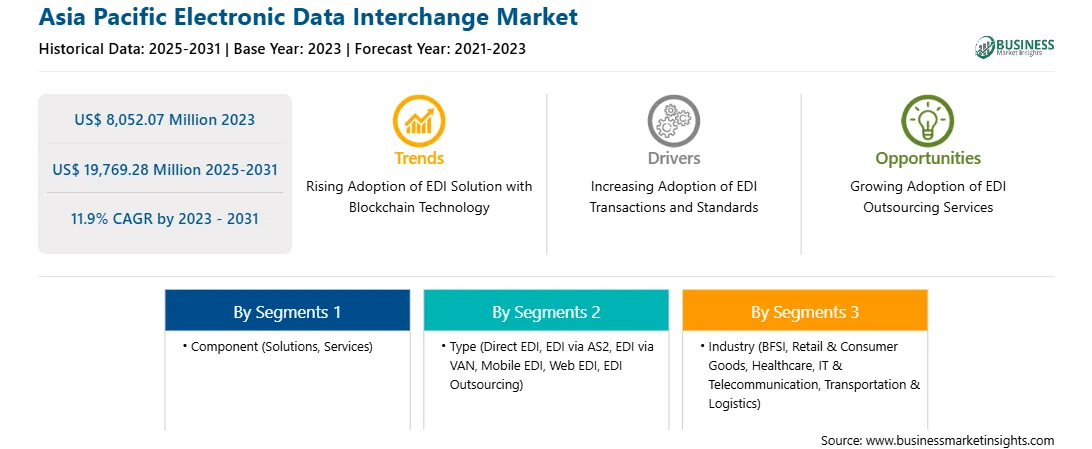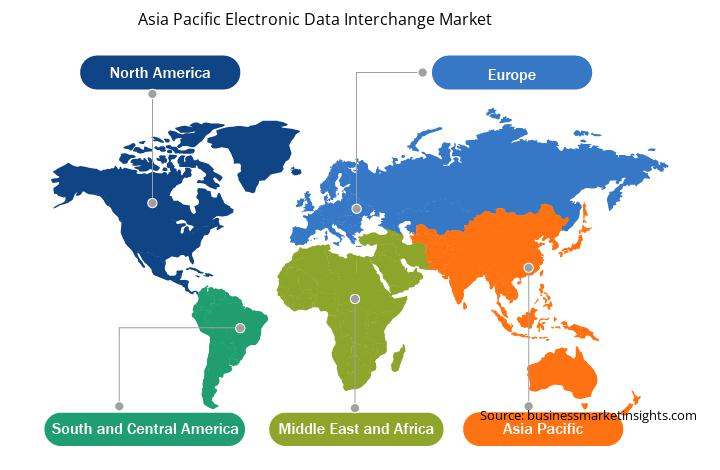The Asia Pacific electronic data interchange market was valued at US$ 8,052.07 million in 2023 and is expected to reach US$ 19,769.28 million by 2031; it is estimated to register a CAGR of 11.9% from 2023 to 2031.
The outsourcing of the EDI program is done via managed services by managing and implementing an EDI platform for a third-party provider. Outsourcing necessitates the organizations to access a wide range of abilities and capital investment of the hardware and software. Several companies are actively focusing on integrating EDI with their back-office systems, including an ERP system that helps achieve the demand for internal resources. Furthermore, the adoption of the managed services approach to EDI has become popular among organizations. The implementation of EDI outsourcing is more engaging than outsourcing across other areas of the IT industry. The significant aim of EDI outsourcing is to reduce the cost of investing in infrastructure by ensuring access to the right level of skills for delivering services to the customer. The implementation of EDI outsourcing offers various benefits such as providing access to the latest technology, getting connected with the external systems, and providing access to the value-added services to permit the user to trade globally. EDI enhances business agility by allowing users to quickly enter new markets and boost business productivity by supplying further and advanced information related to performance, the supply chain, and the business partners. Therefore, the growing demand for EDI outsourcing services is expected to create an opportunity for the growth of the electronic data interchange (EDI) market.
The electronic data interchange (EDI) market in Asia Pacific (APAC) has been analyzed based on historical, current, and future trends in countries across the region. The EDI market players in the region are experiencing significant demand for their solutions and services as the need for EDI is comparatively high across various industries which include retail, IT & telecom, logistics, BFSI, and others. Most of the countries in the region are economically developing, and thus, investment in advanced technologies has increased, facilitating several growth opportunities for the EDI market players. China and Japan are the leading countries in the APAC EDI market due to the steep industrialization rise. The rising adoption of high-end automation solutions among various industries in China and Japan has surged the demand for EDI solutions and services. Several industries, such as BFSI, retail, logistics, and IT, are booming in APAC and are also anticipated to continue to climb substantially during the forecast period, resulting in a rise in the procurement of EDI solutions and services, thereby catalyzing the EDI market. The EDI solution helps the organization to exchange data accurately and securely with their trading partners. They also enable the organization to reduce operational costs and enhance quality. The electronic invoicing scope in the APAC market is increasing gradually. The lack of government initiatives, standards, tax impediments, regulatory framework, and proper understanding of the system within the users are among a few aspects hindering the adoption of EDI solutions. However, the volume of e-invoices exchanged across APAC is increasing from B2C organizations. Thus, it encourages organizations to invest more in "paperless trade," which further boosts the EDI market growth in APAC.
Strategic insights for the Asia Pacific Electronic Data Interchange provides data-driven analysis of the industry landscape, including current trends, key players, and regional nuances. These insights offer actionable recommendations, enabling readers to differentiate themselves from competitors by identifying untapped segments or developing unique value propositions. Leveraging data analytics, these insights help industry players anticipate the market shifts, whether investors, manufacturers, or other stakeholders. A future-oriented perspective is essential, helping stakeholders anticipate market shifts and position themselves for long-term success in this dynamic region. Ultimately, effective strategic insights empower readers to make informed decisions that drive profitability and achieve their business objectives within the market.

| Report Attribute | Details |
|---|---|
| Market size in 2023 | US$ 8,052.07 Million |
| Market Size by 2031 | US$ 19,769.28 Million |
| CAGR (2023 - 2031) | 11.9% |
| Historical Data | 2021-2023 |
| Forecast period | 2025-2031 |
| Segments Covered |
By Component
|
| Regions and Countries Covered | Asia Pacific
|
| Market leaders and key company profiles |
|
The geographic scope of the Asia Pacific Electronic Data Interchange refers to the specific areas in which a business operates and competes. Understanding local distinctions, such as diverse consumer preferences (e.g., demand for specific plug types or battery backup durations), varying economic conditions, and regulatory environments, is crucial for tailoring strategies to specific markets. Businesses can expand their reach by identifying underserved areas or adapting their offerings to meet local demands. A clear market focus allows for more effective resource allocation, targeted marketing campaigns, and better positioning against local competitors, ultimately driving growth in those targeted areas.

The Asia Pacific electronic data interchange market is categorized into component, type, industry, and country.
Based on component, the Asia Pacific electronic data interchange market is bifurcated into solutions and services. The solutions segment held a larger market share in 2023.
In terms of type, the Asia Pacific electronic data interchange market is categorized into direct EDI, EDI via AS2, EDI via VAN, mobile EDI, web EDI, EDI outsourcing, and others. The EDI via AS2 segment held the largest market share in 2023.
By industry, the Asia Pacific electronic data interchange market is segmented into BFSI, retail & consumer goods, healthcare, IT & telecommunication, transportation & logistics, and others. The retail & consumer goods segment held the largest market share in 2023.
By country, the Asia Pacific electronic data interchange market is segmented into Australia, China, Japan, India, South Korea, and the Rest of Asia Pacific. China dominated the Asia Pacific electronic data interchange market share in 2023.
MuleSoft, LLC; Optum Inc; Pacific Commerce Pty Ltd; SPS Commerce Inc; TrueCommerce Inc; Cerner Corp; International Business Machines Corp; Boomi, Inc; GoAnywhere MFT; Cleo; The Descartes Systems Group Inc; Crossinx GmbH; EDICOM; Comarch SA; and InterTrade Systems, Inc. are some of the leading companies operating in the Asia Pacific electronic data interchange market.
The Asia Pacific Electronic Data Interchange Market is valued at US$ 8,052.07 Million in 2023, it is projected to reach US$ 19,769.28 Million by 2031.
As per our report Asia Pacific Electronic Data Interchange Market, the market size is valued at US$ 8,052.07 Million in 2023, projecting it to reach US$ 19,769.28 Million by 2031. This translates to a CAGR of approximately 11.9% during the forecast period.
The Asia Pacific Electronic Data Interchange Market report typically cover these key segments-
The historic period, base year, and forecast period can vary slightly depending on the specific market research report. However, for the Asia Pacific Electronic Data Interchange Market report:
The Asia Pacific Electronic Data Interchange Market is populated by several key players, each contributing to its growth and innovation. Some of the major players include:
The Asia Pacific Electronic Data Interchange Market report is valuable for diverse stakeholders, including:
Essentially, anyone involved in or considering involvement in the Asia Pacific Electronic Data Interchange Market value chain can benefit from the information contained in a comprehensive market report.